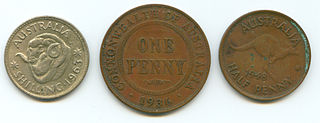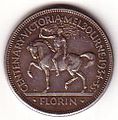- Coins of the Australian pound
-
Federation in 1901 gave the Commonwealth a constitutional power to issue coins and removed this power from the States. However, British coins continued in use until 1910, when Australian silver coins were introduced. These included florins, shillings, sixpences and threepences. They had a portrait of King Edward VII on one side. Australian pennies and half-pennies were introduced into circulation the following year. In 1931 gold sovereigns stopped being minted in Australia. A crown or five-shilling coin was minted in 1937 and 1938.
Contents
Australian £sd
 Australian 1961 half penny and 1964 penny with Kangaroos.
Australian 1961 half penny and 1964 penny with Kangaroos.
In 1898 the British government allowed two colonies, New South Wales and Victoria, to mint silver and bronze coins at their mints in Sydney and Melbourne respectively.
Revaluation
In 1947 due to the cost of WW2 the silver content of the coins was reduced from 0.925 to 0.500 of the coin weight, this lasted until decimalisation of the 14 February 1966. One coin highly sought after by collectors is the penny dated 1930. Its rarity is so well-known amongst Australians, that demand for what is akin to a blue chip investment has pushed prices to approximately 26,000 Australian dollars for an average standard example. A proof example of the same coin recently changed hands for over 620,000 Australian dollars, making it the most expensive copper coin in the world.
Coins
Half Penny (½d)
Penny (1d)
Threepence (3d)
Sixpence (6d)
Shilling (1/-)
Florin (2/-)1910 Series Value Diameter Weight Composition Edge Obverse and Title Reverse Minted Year 3 pence 16 mm 1.41 g 92.5% silver
7.5% copperPlain EDWARDVS VII D: G: BRITT: OMN: REX F: D: IND: IMP: 1908 coat of arms 1910 6 pence 19mm 2.82 g Reeded 1 shilling 23.5 mm 5.65 g 2 shillings = 1 florin 28.5 mm 11.31 g 1911 Series Value Diameter Weight Composition Edge Obverse and Title Reverse Minted Year ½ penny 25.5mm 5.67g Bronze(97% copper, 2.5% zinc, 0.5% tin Plain GEORGIVS V D. G. BRITT: OMN: REX F. D. IND: IMP: Value 1911 – 1936 1 penny 30.8mm 9.45g 3 pence As previous series 1908 coat of arms 6 pence 1 shilling 2 shillings = 1 florin 1937 Series Value Diameter Weight Composition Edge Obverse and Title Reverse Minted Year ½ penny Bronze GEORGIVS VI D: G: BR: OMN: REX F: D: IND: IMP: Value 1938 – 1939 ½ penny Kangaroo 1939 – 1948 1 penny 1938 – 1948 3 pence As previous series three stalks of wheat and a ribbon 1938 – 1944 6 pence 1908 coat of arms 1938 – 1945 1 shilling Merino ram's head 1938 – 1944 2 shillings = 1 florin 1912 coat of arms 1938 – 1945 5 shillings = 1 crown 28.28 g 92.5% silver 7.5% copper Milled Crown 1937 – 1938 1945, 1949, 1953, 1955 Series Series Composition Obverse and Title ½d 1d 3d 6d 1s 2s 1946 50% silver, 40% copper, 5% zinc, and 5% nickel As previous series None None 1947, 1948 1946, 1948 1946, 1948 1946, 1947 1949 ½d & 1d as 1937 series, the rest as previous series GEORGIVS VI D: G: BR: OMN: REX FIDEI DEF 1949 – 1952 1950 – 1952 1951 – 1952 1953 As previous series ELIZABETH . II. DEI. GRATIA. REGINA 1953 – 1955 1953 1953 – 1954 1959 ELIZABETH . II. DEI. GRATIA. REGINA. F: D: 1959 – 1964 1955 – 1964 1955 – 1963 1956 – 1963 See also: Half penny, Penny, threepence, sixpence, shilling, florin, crown.
Pre-decimal commemorative coins
Florin = 2 shillings
-
1927 Australian florin commemorating the opening of the original Parliament House
-
1934-35 Australian florin commemorating the centenary of Victoria and the establishment of Melbourne
-
1951 Australian florin commemorating 50 years of the Commonwealth of Australia
-
The obverse of the commemorative 1927 Australian florin, with
King George V -
The obverse of the commemorative 1951 Australian florin, with
King George VI
References
- Ian W. Pitt, ed (2000). Renniks Australian Coin and Banknote Values (19th ed. ed.). Chippendale, N.S.W.: Renniks Publications. ISBN 0-9585574-4-6.
- Krause, Chester L. and Clifford Mishler (2003). 2004 Standard Catalog of World Coins: 1901–Present. Colin R. Bruce II (senior editor) (31st ed. ed.). Krause Publications. ISBN 0873495934.
External links
- Cruzi's Coins
- Guide to predecimal coins
- History of Australian coins
- Australia's first coins - State Library of NSW
- Commonwealth Pre-Decimal Currency
- Australian Pre-Decimal Currency
Australian currency Topics Mints Coins Banknotes Historic Australian economy History Currency State economies Industries Agriculture · Tourism · Insurance · Property market · Fishing industry · Mining · Wine · Manufacturing · Car industry · Transport · Telecommunications · Ports · SuperannuationTaxation Banking and Finance Regulatory agencies Reserve Bank · ACCC · Corporations law · AIRC · APRA · ASIC · ASX · S&P/ASX 50 · S&P/ASX 200 · Corporations powerEnergy Energy efficiency rating · Biofuel · Wind power · Geothermal power · National Electricity Market · Green electricityEconomic conditions Unions Trade agreements  Category:Economy of AustraliaCategories:
Category:Economy of AustraliaCategories:- Coins of Australia
- Currencies of Australia
-
Wikimedia Foundation. 2010.













